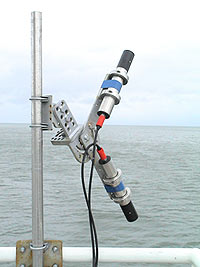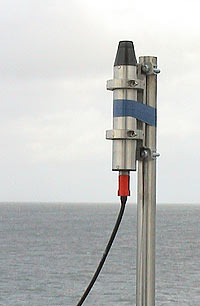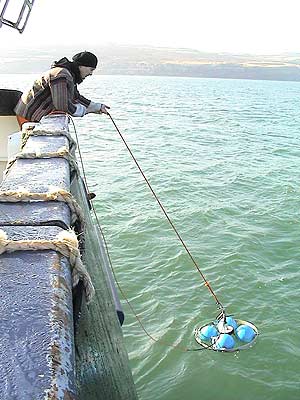The Use of Ferries to Observe Water Quality in the Irish Sea
European funding from the Welsh European Funding Office ( WEFO ) under the INTERREG IIIA programme has enabled the Applied Oceanography Division, part of the University of Wales, Bangor , and the National University of Ireland, Galway to team up with Irish Ferries in order to carry out a water quality study in the Irish Sea.
The project will be investigating the use of above-water radiometers deployed from ships of opportunity for the retrieval of water quality parameters from ocean colour information. The ultimate aim of this project is to improve current capabilities for the long term autonomous monitoring of water quality in the Irish Sea.
In September 2003, optical sensors (left) measuring ocean colour from above the sea surface will be placed on the Irish Ferries' Ulysses, crossing between Holyhead and Dublin. Work is currently underway to establish measurement protocols and develop water quality algorithms during sea trials on board the University research vessels the Prince Madog and Celtic Voyager.
The instruments will enable the detection of small changes in the colour of surface waters of the Irish Sea during twice daily crossings, which will provide us with an indication of water quality. Variations in ocean colour will provide valuable information on water clarity, sediment loading, frequency and magnitude of phytoplankton blooms (including nuisance algae). It is expected that the Irish Sea waters will appear browner and carry more sediment during the winter months, appear greener in spring as the plankton or algae in the water blooms and will clear during the summer months to give a deep blue colour. The detectors will also pick up any immediate changes due to pollutants such as oil.
The information from the sensors on board the ferry will provide us with a unique, continuous and potentially long term record of the water quality of the central Irish Sea, which would not be possible through current monitoring techniques. Such a record would be invaluable for marine environmental monitoring and protection of the region.
- To calibrate measurements from autonomous optical instruments against water quality parameters (including algal blooms, sediment loading and water clarity) at sea from research vessels.
- To install and commission the optical instruments on the Irish Ferry, Ulysses, which crosses the Irish Sea between Holyhead and Dublin on a daily basis.
- To acquire a long time series of ocean colour data and, therefore, water quality parameters, between Holyhead and Dublin from these instruments.
- To ascertain the feasibility of using these methods for long term water quality monitoring in Irish Sea waters.



RAMSES radiance and Irradiance sensors (TriOS Optical Sensors) mounted on the University of Wales Bangor research vessel, the Prince Madog during sea trials in February 2003.
The project is being part funded through the INTERREG IIIA Community Initiative which supports joint Irish/Welsh projects with the aim of promoting the sustainable development of the cross-border region through an integrated approach to economic, social and environmental development.
The Interreg IIIA programme is administered by the Welsh European Funding Office, which is part of the Welsh Assembly Government who are the Managing Authority for European Structural Funds in Wales.
